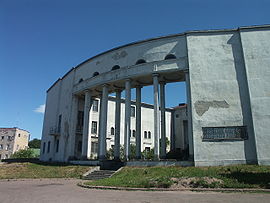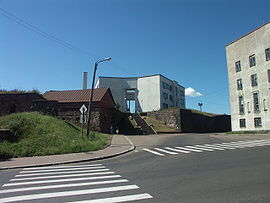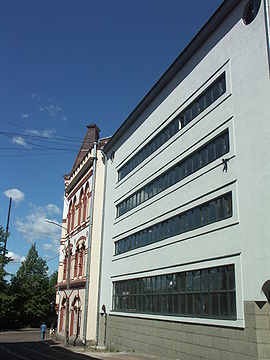
Uno Ullberg
Encyclopedia

Finland
Finland , officially the Republic of Finland, is a Nordic country situated in the Fennoscandian region of Northern Europe. It is bordered by Sweden in the west, Norway in the north and Russia in the east, while Estonia lies to its south across the Gulf of Finland.Around 5.4 million people reside...
architect
Architect
An architect is a person trained in the planning, design and oversight of the construction of buildings. To practice architecture means to offer or render services in connection with the design and construction of a building, or group of buildings and the space within the site surrounding the...
. Was the first to introduce to Viipuri the important international tendency in architecture known as Functionalism
Functionalism (architecture)
Functionalism, in architecture, is the principle that architects should design a building based on the purpose of that building. This statement is less self-evident than it first appears, and is a matter of confusion and controversy within the profession, particularly in regard to modern...
. Though authors most notable buildings were constructed in Viipuri, he became famous not only in his native town but nation-wide.
Education and early works
Ullberg graduated from the architectural faculty in Helsinki Polytechnic StadiaHelsinki Polytechnic Stadia
Helsinki Polytechnic Stadia is a multidisciplinary institution of higher education, one of the biggest and the most attractive polytechnic in Finland in 2005. Helsinki Polytechnic Stadia offers students an international learning environment with a wide variety of higher education level studies...
. After returning in 1906 to the native town he joined his co-ed Klaes Axel Gulden for the purpose of setting-up their own architectural bureau.
They worked together until 1909, when Ullberg decided to quit and to start working under his own name.
The most important work created in collaboration with Gulden was the headquarters of "Hackman & Co" in Viipuri, 1909], Piispankatu 14.
The building represents the compositional and formal variations of Art Nouveau
Art Nouveau
Art Nouveau is an international philosophy and style of art, architecture and applied art—especially the decorative arts—that were most popular during 1890–1910. The name "Art Nouveau" is French for "new art"...
or national Romanticism
Romanticism
Romanticism was an artistic, literary and intellectual movement that originated in the second half of the 18th century in Europe, and gained strength in reaction to the Industrial Revolution...
. The main elevation pediments, openings, window frames, portals, the granite facing are quite common to the typical manner of Romanticism. The interiors of the building were among the most stylish and rich in the city. The inside of the house survived harmful transformations during the Soviet period so the interior decorations were greatly damaged.
After leaving the collaboration with Gulden Uno Ullberg continued the work alone. Between 1910–1930 he created a large number of public buildings situated not only in Viipuri but in some other important locations around the town.
Among them are several office buildings in Priozersk
Priozersk
Priozersk is a town in Leningrad Oblast, Russia, centered on an island at the southwestern shore of Lake Ladoga, at the estuary of the northern armlet of River Vuoksi on the Karelian Isthmus. It is served by a station of the Saint Petersburg-Kuznechnoye railroad with the same name...
(former Käkisalmi), Imatra
Imatra
Imatra is a town and municipality in eastern Finland, founded in 1948 around three industrial settlements near the Finnish–Russian border. In the course of the last 50 years, this amorphous group of settlements has grown into a modern industrial town dominated by Lake Saimaa, the Vuoksi River and...
and other Finnish towns.
The early works in Viipuri could be described as the traditional town architecture with the classicistic influence. The most interesting instances of the period are reconstruction of 1900-built "Union bank", the "Karjala" offices, 1929, the trade-house and residence of V. Dippel, 1921 and one of the most famous works - reconstruction of the famous medieval Round Tower in the middle of the old city centre. Ullberg converted the massive old building into a comfortable cafe.
The most important period in Ullberg's life is connected with the period known as the White Era.
The White Era
"White era of FunctionalismFunctionalism (architecture)
Functionalism, in architecture, is the principle that architects should design a building based on the purpose of that building. This statement is less self-evident than it first appears, and is a matter of confusion and controversy within the profession, particularly in regard to modern...
". The name is associated with the most popular painting color - white - used for the elevations of stuccoed functionalistic buildings of 1920–1930-s.
Ullberg found his own unique conception and interpretation of functionalistic architecture. The main aspect of his philosophy is connection between functional and traditional. In his works Ullberg always used the Classicist
Classicism
Classicism, in the arts, refers generally to a high regard for classical antiquity, as setting standards for taste which the classicists seek to emulate. The art of classicism typically seeks to be formal and restrained: of the Discobolus Sir Kenneth Clark observed, "if we object to his restraint...
background: emphasized, reductive common elements of Classicism.

The most perfect and surprising is the Viipuri Art Museum and Drawing School house. Built in October 1930 the construction is situated on the reserved by Viipuri Art Society (1928) top of 16th Century Pantsarlahti Bastion in the southern end of the city. Contrasting from its fortress environment with stone-supported land walls, the white-stuccoed building commands the view over the South Harbor and the approach from the sea.
The massing of the building is of two wings (the Art Museum on the east wing, Drawing School on the west) placed at an angle with each other, with a wedge-shaped, paved courtyard separating the two. The wider part of the courtyard faces south-west, the harbor, and there is an imposing twin-row Classistic colonnade of pillars with a rectangular cross-section, supporting an equally stylistic curving architrave with half-oculi, doubling as a corridor that connects the two buildings.
The approach to the museum from the city is through a series of flights of steps leading to an opening, set at an angle, between the windowless north walls of the wings. The walls facing south are almost as austere, with the central colonnade acting as the focal point.

The four-storey building of the Viipuri Panttilaitos Oy the first completed example of Functionalistic movement in the city. It has as many rows of distinct, very simplified bands of windows, or rather, more like four very wide windows with very thin mullions. The first floor fenestration consists of a double row of windows, 22 in a row (that are hinged from the bottom, opening downwards), while the upper three only have one. The bold fenestration is enabled by the use of a solid reinforced concrete
Reinforced concrete
Reinforced concrete is concrete in which reinforcement bars , reinforcement grids, plates or fibers have been incorporated to strengthen the concrete in tension. It was invented by French gardener Joseph Monier in 1849 and patented in 1867. The term Ferro Concrete refers only to concrete that is...
girderless framework with "mushroom form" columns that free the brick facade of its load-bearing function. The cross-section of columns on the last stage is much smaller than on the first one, it's because of the increase of mechanical tension down from the roof the basement.
Ullberg was very successful in designing medical facilities. During the White Era he built a number of very important hospitals in Viipuri.
Ullberg worked not only with his own bureau, but also acted as the Viipuri city architect in 1932–1936. During this period he controlled the urban conception of the city and worked on the Master plan
Master plan
A master plan has many meanings, it can refer to:Generally it may be used for serious plans or strategies, see:*Strategy**Strategic planning**Comprehensive planning**Blueprint...
.
The last ages of life
In 1936 Ullberg moved to Helsinki where he became the head of the architectural bureau of the National Board of Health. This job was connected to his great experience in medical buildings theory and his practical achievements.After the Winter War
Winter War
The Winter War was a military conflict between the Soviet Union and Finland. It began with a Soviet offensive on 30 November 1939 – three months after the start of World War II and the Soviet invasion of Poland – and ended on 13 March 1940 with the Moscow Peace Treaty...
with Soviet Union
Soviet Union
The Soviet Union , officially the Union of Soviet Socialist Republics , was a constitutionally socialist state that existed in Eurasia between 1922 and 1991....
when after the short period of being a soviet city in 1941 Viipuri was returned to Finland, Ullberg was fast to create the plan of reconstruction for his native town (1941). But Finland had no time and no possibility to bring the plan to life.
Ullberg died in Helsinki in 1944 in the age of 65.
Important buildings
- 1909, Headquarters of "Hackman & Co", VyborgVyborgVyborg is a town in Leningrad Oblast, Russia, situated on the Karelian Isthmus near the head of the Bay of Vyborg, to the northwest of St. Petersburg and south from Russia's border with Finland, where the Saimaa Canal enters the Gulf of Finland...
, RussiaRussiaRussia or , officially known as both Russia and the Russian Federation , is a country in northern Eurasia. It is a federal semi-presidential republic, comprising 83 federal subjects... - 1911-1915, Finland Trade Bank offices and residence, VyborgVyborgVyborg is a town in Leningrad Oblast, Russia, situated on the Karelian Isthmus near the head of the Bay of Vyborg, to the northwest of St. Petersburg and south from Russia's border with Finland, where the Saimaa Canal enters the Gulf of Finland...
, RussiaRussiaRussia or , officially known as both Russia and the Russian Federation , is a country in northern Eurasia. It is a federal semi-presidential republic, comprising 83 federal subjects... - 1913, United Northern Bank Building, SortavalaSortavalaSortavala is a town in the Republic of Karelia, Russia, located at the northern tip of Lake Ladoga. Population: It is an important station of the Vyborg-Joensuu railroad.-History:...
, RussiaRussiaRussia or , officially known as both Russia and the Russian Federation , is a country in northern Eurasia. It is a federal semi-presidential republic, comprising 83 federal subjects... - 1915, Bank Office, SortavalaSortavalaSortavala is a town in the Republic of Karelia, Russia, located at the northern tip of Lake Ladoga. Population: It is an important station of the Vyborg-Joensuu railroad.-History:...
, RussiaRussiaRussia or , officially known as both Russia and the Russian Federation , is a country in northern Eurasia. It is a federal semi-presidential republic, comprising 83 federal subjects... - 1921, trade-house and residence of V. Dippel, VyborgVyborgVyborg is a town in Leningrad Oblast, Russia, situated on the Karelian Isthmus near the head of the Bay of Vyborg, to the northwest of St. Petersburg and south from Russia's border with Finland, where the Saimaa Canal enters the Gulf of Finland...
, RussiaRussiaRussia or , officially known as both Russia and the Russian Federation , is a country in northern Eurasia. It is a federal semi-presidential republic, comprising 83 federal subjects... - 1929, "Karjala" offices, VyborgVyborgVyborg is a town in Leningrad Oblast, Russia, situated on the Karelian Isthmus near the head of the Bay of Vyborg, to the northwest of St. Petersburg and south from Russia's border with Finland, where the Saimaa Canal enters the Gulf of Finland...
, RussiaRussiaRussia or , officially known as both Russia and the Russian Federation , is a country in northern Eurasia. It is a federal semi-presidential republic, comprising 83 federal subjects... - 1930, Apartment house with public spaces, VyborgVyborgVyborg is a town in Leningrad Oblast, Russia, situated on the Karelian Isthmus near the head of the Bay of Vyborg, to the northwest of St. Petersburg and south from Russia's border with Finland, where the Saimaa Canal enters the Gulf of Finland...
, RussiaRussiaRussia or , officially known as both Russia and the Russian Federation , is a country in northern Eurasia. It is a federal semi-presidential republic, comprising 83 federal subjects... - 1930, Viipuri Art Museum and Drawing School, VyborgVyborgVyborg is a town in Leningrad Oblast, Russia, situated on the Karelian Isthmus near the head of the Bay of Vyborg, to the northwest of St. Petersburg and south from Russia's border with Finland, where the Saimaa Canal enters the Gulf of Finland...
, RussiaRussiaRussia or , officially known as both Russia and the Russian Federation , is a country in northern Eurasia. It is a federal semi-presidential republic, comprising 83 federal subjects... - 1930, Hospital Building, VyborgVyborgVyborg is a town in Leningrad Oblast, Russia, situated on the Karelian Isthmus near the head of the Bay of Vyborg, to the northwest of St. Petersburg and south from Russia's border with Finland, where the Saimaa Canal enters the Gulf of Finland...
, RussiaRussiaRussia or , officially known as both Russia and the Russian Federation , is a country in northern Eurasia. It is a federal semi-presidential republic, comprising 83 federal subjects... - 1931, Viipurin Panttilaitos Oy Building, VyborgVyborgVyborg is a town in Leningrad Oblast, Russia, situated on the Karelian Isthmus near the head of the Bay of Vyborg, to the northwest of St. Petersburg and south from Russia's border with Finland, where the Saimaa Canal enters the Gulf of Finland...
, RussiaRussiaRussia or , officially known as both Russia and the Russian Federation , is a country in northern Eurasia. It is a federal semi-presidential republic, comprising 83 federal subjects... - 1932, Swedish-German Pietari-Paavali (Peter and Paul) Lutheran congregation, VyborgVyborgVyborg is a town in Leningrad Oblast, Russia, situated on the Karelian Isthmus near the head of the Bay of Vyborg, to the northwest of St. Petersburg and south from Russia's border with Finland, where the Saimaa Canal enters the Gulf of Finland...
, RussiaRussiaRussia or , officially known as both Russia and the Russian Federation , is a country in northern Eurasia. It is a federal semi-presidential republic, comprising 83 federal subjects... - 1932-1933, Viipuri Provincial Archives, VyborgVyborgVyborg is a town in Leningrad Oblast, Russia, situated on the Karelian Isthmus near the head of the Bay of Vyborg, to the northwest of St. Petersburg and south from Russia's border with Finland, where the Saimaa Canal enters the Gulf of Finland...
, RussiaRussiaRussia or , officially known as both Russia and the Russian Federation , is a country in northern Eurasia. It is a federal semi-presidential republic, comprising 83 federal subjects... - 1935, Bus Station Office, SortavalaSortavalaSortavala is a town in the Republic of Karelia, Russia, located at the northern tip of Lake Ladoga. Population: It is an important station of the Vyborg-Joensuu railroad.-History:...
, RussiaRussiaRussia or , officially known as both Russia and the Russian Federation , is a country in northern Eurasia. It is a federal semi-presidential republic, comprising 83 federal subjects... - 1937, Viipuri Hospital Maternity and Women's Wards, VyborgVyborgVyborg is a town in Leningrad Oblast, Russia, situated on the Karelian Isthmus near the head of the Bay of Vyborg, to the northwest of St. Petersburg and south from Russia's border with Finland, where the Saimaa Canal enters the Gulf of Finland...
, RussiaRussiaRussia or , officially known as both Russia and the Russian Federation , is a country in northern Eurasia. It is a federal semi-presidential republic, comprising 83 federal subjects... - 1937, Reconstruction of Bus Station, VyborgVyborgVyborg is a town in Leningrad Oblast, Russia, situated on the Karelian Isthmus near the head of the Bay of Vyborg, to the northwest of St. Petersburg and south from Russia's border with Finland, where the Saimaa Canal enters the Gulf of Finland...
, RussiaRussiaRussia or , officially known as both Russia and the Russian Federation , is a country in northern Eurasia. It is a federal semi-presidential republic, comprising 83 federal subjects...

